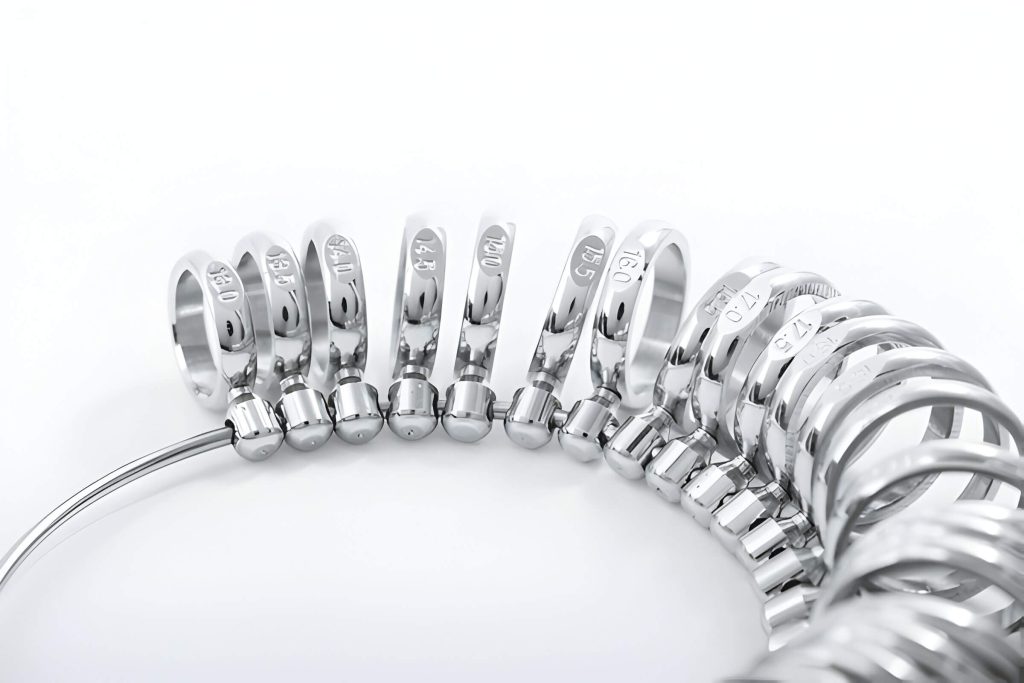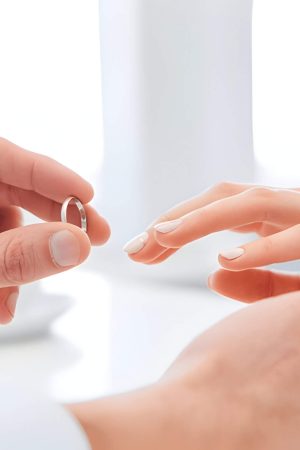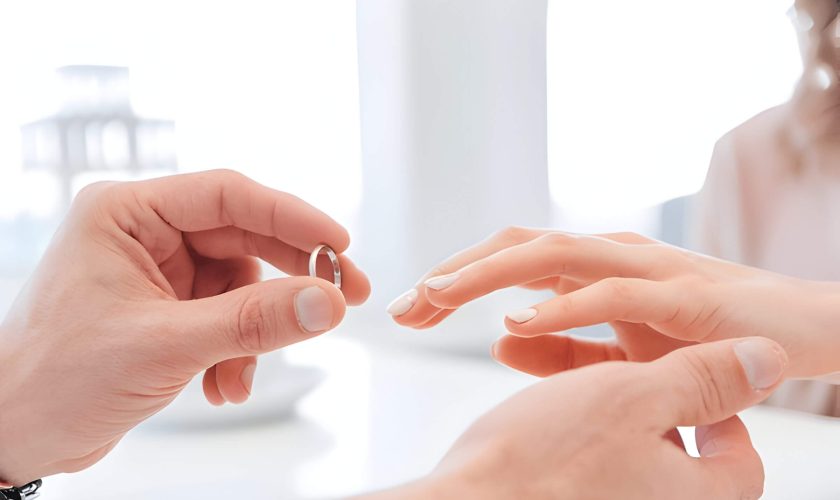When it comes to purchasing a ring, knowing your ring size is crucial for several reasons. The importance of ring size cannot be overstated, as it ensures that you achieve the perfect ring fit. An accurate ring size measurement is essential not only for comfort but also for the longevity and security of your jewelry.
Firstly, a well-fitted ring feels comfortable and secure on your finger. If a ring is too tight, it can cause discomfort and even restrict blood flow. Conversely, if it’s too loose, there’s a risk of losing the precious piece altogether. Therefore, having an accurate measurement helps in avoiding these issues.
Secondly, an accurately sized ring looks more aesthetically pleasing. A perfect fit ensures that the gemstone or design stays centered and doesn’t spin around your finger. This stability enhances the overall appearance of the jewelry.
Lastly, proper jewelry fitting can affect the durability of your piece. Rings that are either too tight or too loose are more likely to suffer from wear and tear over time. Ensuring that you have an accurate ring size measurement means that your rings will last longer and maintain their original beauty.
In summary, understanding the importance of knowing your ring size cannot be emphasized enough when aiming for comfort, security, aesthetic appeal, and durability in your jewelry pieces.
Methods to Measure Your Ring Size at Home
Choosing the perfect ring requires knowing your exact ring size, but what if you can’t make it to a jeweler? Fortunately, there are several methods to measure your ring size at home accurately. Here are three popular DIY techniques:
1. String Method: One of the simplest ways to measure your ring size at home is by using a piece of string. Wrap the string around the base of your finger, ensuring it is snug but not too tight. Mark where the string overlaps with a pen, then lay it flat and measure its length in millimeters using a ruler. Compare this measurement with a standard ring size chart to find your corresponding size.
2. Paper Strip Method: Similar to the string method, this technique involves cutting a thin strip of paper about 100mm long and 10mm wide. Wrap it around your finger and mark where it overlaps with itself. Lay the paper flat and measure its length in millimeters from one end to the marked point. Use this measurement against a ring sizing chart for an accurate result.
3. Ruler and Paper Method: This method requires you to have an existing well-fitting ring on hand. Place the ring on top of a ruler and measure its internal diameter in millimeters from edge to edge at its widest point. Cross-reference this diameter with an online ring sizing chart to determine your correct size.
These DIY methods for measuring your ring size at home are convenient and reliable solutions when professional sizing isn’t accessible. Always double-check measurements for accuracy before making any purchase decisions.
Using a Ring Sizer Tool for Accurate Measurement

When it comes to finding the perfect ring, ensuring a precise fit is crucial. A ring sizer tool is an invaluable asset in achieving accurate measurements, whether you’re shopping for an engagement ring or simply updating your jewelry collection. Here’s how to use a ring sizer tool effectively and why professional ring measurement tools are recommended.
First, understand that there are various types of ring sizer tools available, including plastic strips, metal rings on a keyring, and adjustable mandrels. Each type serves the same purpose but may offer different levels of precision. For the most accurate results, professional jewelers often rely on metal gauge rings or digital sizing tools.
To use a basic plastic or metal ring sizer tool at home:
- Choose the type of sizer you have (strip or keyring).
- Slide your finger into each size until you find one that fits comfortably without being too tight.
- Ensure there is slight resistance when removing the sizer; this indicates a snug fit.
- Note down the size indicated on the tool.
For those seeking even greater accuracy, visiting a jeweler who uses professional ring measurement tools can be beneficial. These tools provide precise readings by accommodating various finger shapes and sizes more accurately than home kits.
In summary, using a ring sizer tool is straightforward but requires attention to detail for best results. Whether opting for an at-home kit or seeking professional assistance, accurate measurements ensure comfort and security in your chosen piece of jewelry.
The Role of Temperature and Time of Day in Measuring Ring Size
When it comes to measuring ring size, both temperature and time of day play crucial roles in ensuring accurate results. The temperature effect on finger size is significant; fingers tend to swell in warmer conditions and shrink when it’s cold. This fluctuation can lead to inaccurate measurements if not accounted for properly.
The best time to measure ring size is during the middle of the day, when your body temperature is relatively stable. Early mornings may yield smaller measurements due to cooler temperatures and reduced blood flow, while late evenings might show larger sizes because of daily activities causing finger swelling.
To avoid inaccurate measurements, it’s essential to consider these factors. Measure your ring size at a consistent time of day and in a comfortable room temperature setting. By doing so, you’ll ensure that the ring fits perfectly under normal conditions, avoiding any discomfort or need for resizing later on.
Consulting a Professional Jeweler for Exact Measurements
When it comes to ensuring the perfect fit for your jewelry, consulting a professional jeweler is paramount. Professional jeweler advice can make all the difference in achieving precise measurements for your treasured pieces. Whether you’re purchasing a new ring or resizing an existing one, visiting a jewelry store for accurate measurements is essential.
Expert ring sizing tips from seasoned jewelers can help you avoid common pitfalls associated with incorrect sizing. They utilize reliable measurement methods that take into account various factors such as finger size fluctuations due to temperature and time of day. By leveraging their expertise, you ensure that your jewelry fits comfortably and securely.
Moreover, professional jewelers have access to specialized tools and equipment that provide more exact measurements than DIY methods. This precision is crucial not only for comfort but also for the longevity and integrity of your jewelry. Trusting a knowledgeable jeweler ensures that your valuable pieces are measured with the utmost care and accuracy, giving you peace of mind and satisfaction with every wear.
Troubleshooting Common Issues When Measuring Ring Size
When it comes to measuring ring size, accuracy is paramount to ensure a comfortable and secure fit. However, common mistakes can often lead to incorrect measurements. Here are some troubleshooting tips for addressing these issues:
1. Using Improper Tools: One of the most frequent mistakes is using non-standard tools like strings or paper strips. These materials can stretch or compress, leading to inaccurate readings. Instead, use a proper ring sizer or visit a jeweler for precise measurement.
2. Measuring at the Wrong Time of Day: Finger sizes can fluctuate due to temperature changes and physical activity. Measuring your finger when it’s too cold or too hot can result in an incorrect size. Aim to measure your finger at room temperature and preferably at the end of the day when your fingers are likely at their largest.
3. Ignoring Knuckle Size: If you have larger knuckles, you might find that a ring that fits over them is too loose on the finger itself. In such cases, consider opting for half sizes or rings with adjustable bands.
4. Not Accounting for Ring Width: Wider rings tend to fit more snugly than narrow ones due to increased surface area contact with the skin. When measuring for a wider band, it might be necessary to go up by half a size to ensure comfort.
5. Rechecking Measurements: Always double-check your measurements before making any purchase decisions. A slight error in reading could lead to discomfort and potential resizing costs later on.
By being aware of these common mistakes in measuring ring size and knowing how to fix wrong measurements, you can ensure a correct fit every time you shop for rings.


